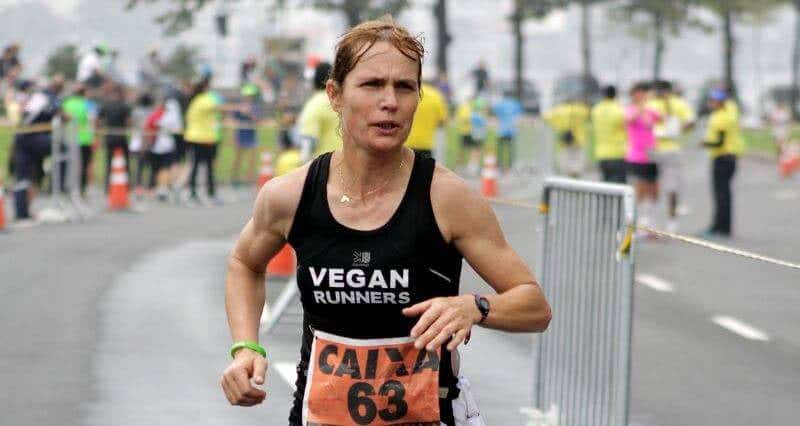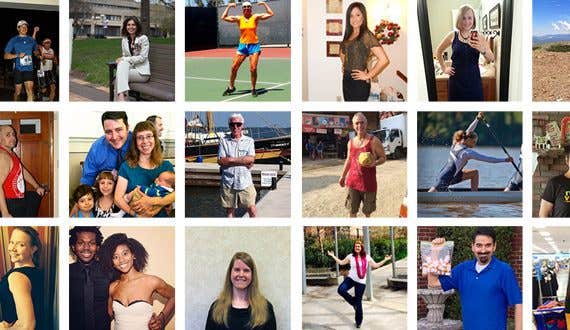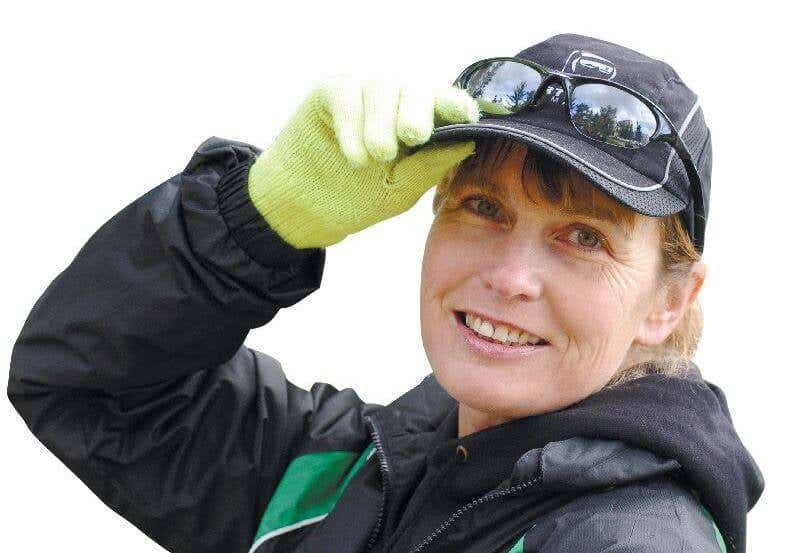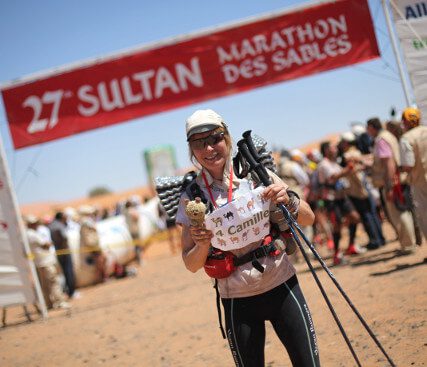
Vegan Ultra Athlete for the Animals: How I Became a Triple Guinness World Record Holder
My name is Fiona Oakes, an ethical vegan since age six and vegetarian since age three. I am vegan by instinct—a natural expression of my love for animals and my desire not to hurt those I care for. My veganism is, and always has been, the predominant force and influence in my life. Vegan is not what I am; it is who I am, as far back as I can remember.
It wasn’t easy at the start—no one in my family was vegan, or even vegetarian, and (with the exception of my mother) they discouraged me from following a plant-based lifestyle. This was over forty years ago, and since that time things have changed a great deal, with much more veg-friendly information available in the popular press to support my vision of plant-based living for all.
Even though I am an elite marathon runner and triple Guinness World Record holder, I am primarily an animal advocate and caregiver. If I don’t think an animal will benefit either directly or indirectly from my actions, I reconsider them. Almost every day of my life is spent caring and providing for rescued animals at the Tower Hill Stables Animal Sanctuary, a facility I founded more than two decades ago, just outside London in the UK. Currently it is home to over four hundred rescued animals, both domestic and farmed, who have come into my care from various desperate situations. All are welcome, all are treated equally with the respect and dignity that is their birthright, and each life is precious.
My days are long and filled with work and worry—I rise at 3:30 am and finish when all are cared for and comfortable, usually around 9 pm. It’s a grueling regimen, one that continues daily, regardless of weather, season, or circumstances. Some see living this way to be a sacrifice; I see it as an honor and a privilege to be able to provide a haven to so many vulnerable victims, often of human violence.
Starting the Sanctuary
The sanctuary was an enormous undertaking, something I could not possibly have envisioned those twenty-plus years ago when I started it. I had always rescued animals in a small and simple way, but when one of my horses had a terrible accident due to the negligence of a stable owner, I decided to create a home for the animals I loved. After that, frantic preparations began and the mammoth process of raising the necessary funds to buy land commenced. It was huge; it seemed insurmountable. We sold everything we possessed of any value, and somehow we did it.
On the 5th December, 1996, my partner Martin and I moved to the sanctuary, with our family of animal friends. The next day, our injured horse Oscar came “home,” living happily for another four years, until old age eventually took him from us.
Since that time, the sanctuary has just grown and grown, out of the desperate need of so many animals who require help. Currently we have horses, sheep, cattle, pigs, goats, turkeys, chickens, ducks, peacocks, dogs, cats, and rabbits—many rescued from the exploitative farming, meat, and dairy industries … some simply “thrown out” because they are elderly, infirm, ill, or just unwanted. We don’t discriminate or question the reasons for their plight, we just attempt to find the answer and end to it.
After several years, I realized that running the sanctuary was not enough—not for me and certainly not for the animals. Yes, I could deliver care and comfort to a select few, but what about the millions and millions who are suffering and beyond my reach? I had to do more. The problem weighed on my mind for week, months, and years until I came up with a plan: I needed to become good at something tough, really tough, that would prove emphatically the viability—or, in my view, the superiority—of a plant based diet.
Becoming a Runner
I was always good at sports, and at some point I hit upon the idea of running. I wanted to demonstrate to the world that a plant-based diet was good for performance. How would I become a good runner? Dedication, discipline, determination, and drive were the answer. I knew I wasn’t in the best physical condition to achieve this goal, as multiple knee surgeries as a teenager had left me partially disabled and without the pivotal fulcrum of a right kneecap. I had a disability but I also had a strength: I wasn’t doing it for me; I was doing it for the animals, and to prove that I could achieve results as a lifelong plant eater that others could only dream of. When the training got hard, I remembered why I was doing it: my pain was voluntary; theirs was not—that thought was all I needed to drive myself on, and that is exactly what I have been doing ever since.
This drive has taken me to multiple marathon victories, a personal best time of 2 hours 38 minutes, and top-twenty placement in two of the World Marathon Major series (Berlin and London). Having achieved all this, I began to look at my results and wonder if they were making the difference for the animals I desired.
Marathon des Sables, a 150-Mile Race Across the Sahara Desert
In 2011, someone suggested I try something completely different, something physically and mentally challenging in other ways. They mentioned the Marathon des Sables, known as “the toughest footrace on the planet,” a 150-mile ultrarun across the Sahara Desert, in which you carry all your supplies on your back for five or six days. In addition to the actual running, the hazards include daytime temperatures of over 54°C (129°F). and freezing temperatures at night, 800-foot sand dunes, blisters, dehydration, and primitive living with absolutely no daily comforts—just basic tent facilities at the end of each stage and very limited rationed water.
I was desperate to prove I could do it, even with the added challenges of an ultraheavy pack due to my ethically sourced kit, limited availability of dehydrated foods, and recovery drinks that made my pack heavier than normally acceptable. I just had to prove it possible: if I could do this as a vegan, then who could argue any reason, either dietary or otherwise, for not following suit?
My task was made none the easier as I broke two toes trying to assist an elderly horse, Charity, to her feet the week before the race. I was advised not to race, but I had to try. It was one of the hardest things I have ever done. The broken toes caused me all sorts of added problems—the scarring to my feet, blisters, and swelling caused the bone in one of my toes to show through, but despite all this I finished the race … because when things became bad and I felt darkest, I clung on to my reasons for being there and what this accomplishment might achieve.
The Polar Marathons
Having completed Marathon des Sables, I decided to attempt the polar (North Pole and Antarctic Ice) marathons, simply because they were at the other end of the spectrum. I didn’t know how, or if, I would cope with the brutality of the icy conditions. I think I shocked myself even more than the other competitors when I won the first race at the North Pole by a massive margin, setting a new course record!
After this victory, fellow competitors who were more specialized in this sort of running suggested that I consider tackling the world record by attempting to become the fastest woman to run a marathon on every continent plus the North Pole. Since I was entered in the Antarctic race seven months later, this was an option. However the reality of obtaining funding for such a venture did make it seem less viable as time ticked by. It was only at the last minute, in August, that I decided I had to go.
The publicity I would gain as a vegan successfully completing this challenge was something I could not afford to miss in my efforts to promote ethical plant-based living to the masses. At the time, the only potential source of money on my horizon was to re-mortgage my parent’s house. But fortunately, at the very last minute, a private sponsor stepped in and offered help. Then the frenzy of the challenge began.
Becoming the Fastest Woman to Run a Marathon on Every Continent
Every week or two I was off for a couple of days to a different continent, dashing off the plane, running the marathon, and then returning straight home to care for the animals. I made the journey from the UK to Australia and back in less than four days with no jet lag—and grabbed a podium place in the marathon, to boot!
Those few weeks were so hectic and stressful. Trying to stay well and injury-free, and to physically make the start of all the races, was an enormous challenge on many levels. It nearly all fell apart in the penultimate race—the highest average altitude marathon ever held—in the Atacama Desert. In order to save the money and time required for two costly trips to South America (one to race there and one in transit to Antarctica), I combined the trips. But I injured my knee in the Atacama race, so severely that doctors told me I would not run again that year, let alone five days later in Antarctica. I was desperate and disappointed.
By now, because I had been running each race so quickly, three potential world records were on the line. I had to go; I had to try and complete the race in Antarctica. Even if I were to walk ’round, I had to finish. As I stood on the start line of that race I felt nervous, frightened, and demoralized, but not defeated—never defeated, until I draw my last breath. I can’t remember much about the race other than that it was hard and cold. I set a new marathon world record by running 7 marathons on 7 continents in 23 hours and 27 minutes. How I won it, how I broke the course record, again I do not know. All I know is that in 2013 this is what I did—not for me, but for the animals.
(Above: Fiona running the Antarctic Ice Marathon in minus 20 degrees. She won and broke the course record.)
What’s Next
Now it’s time to wake up and look forward. This year I will attempt to break my own world records in the London Marathon in April where I have an elite place. There, amongst some of the best runners in the world, I will be particularly proud to sport my Vegan Runner vest, as an honorary member of the club after having been instrumental in starting it some eleven years ago.
Then, three weeks later, I will attempt to become one of only a handful of women to complete the 4 Deserts Grand Slam—an ultra endurance event consisting of a week each in the Sahara, Gobi, Atacama, and Antarctic deserts. These races are mentally, physically, spiritually, and logistically challenging alike—but they certainly serve to prove that veganism is a viable and valid option for all.
After that, who knows? All I do know is that for me the animals will always come first.
WATCH For the Animals, a documentary about Fiona.

Has a whole-food, plant-based diet impacted your life?
We would love to hear about it!
SHARE YOUR STORY
About the Author

About the Author
Fiona Oakes
Join our mailing list
Get free recipes and the latest info on living a happy, healthy plant-based lifestyle.
By providing your email address, you consent to receive newsletter emails from Forks Over Knives. We value your privacy and will keep your email address safe. You may unsubscribe from our emails at any time.
